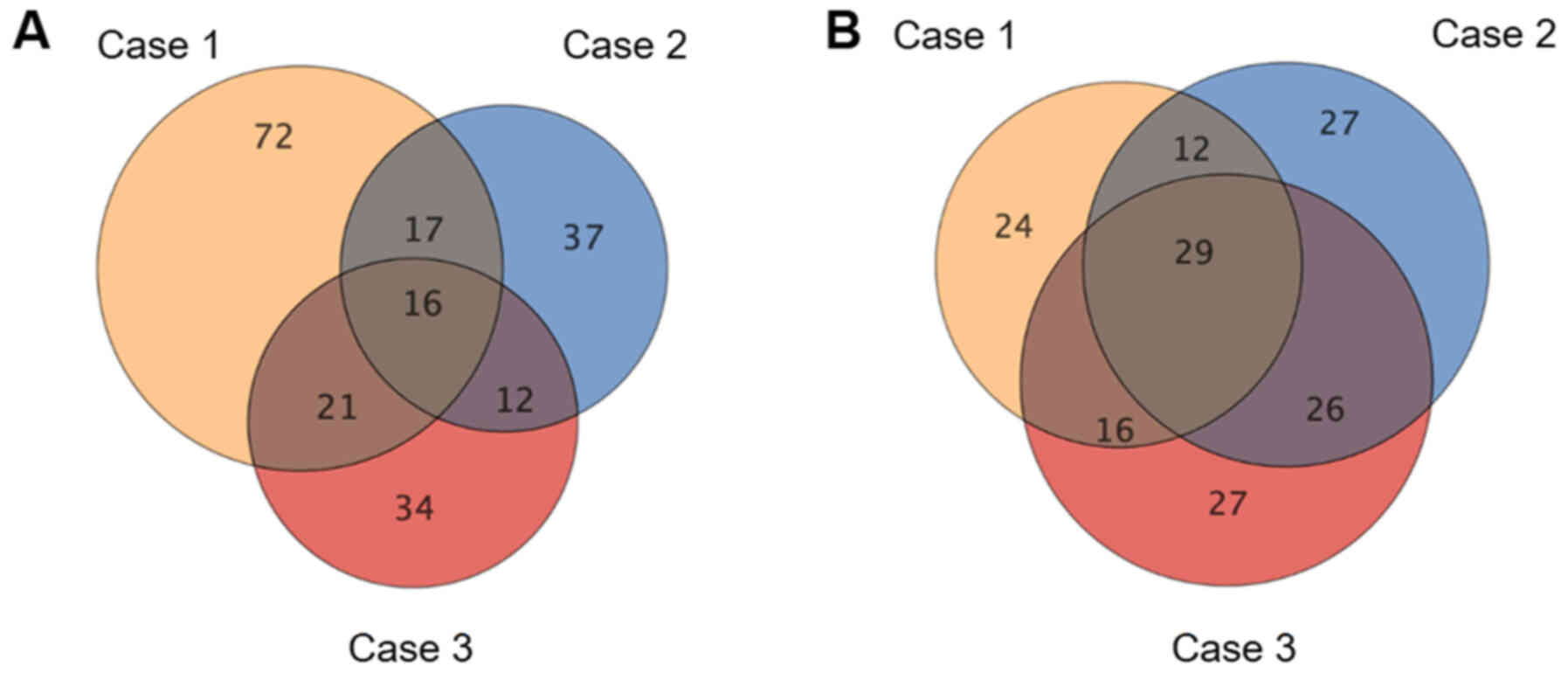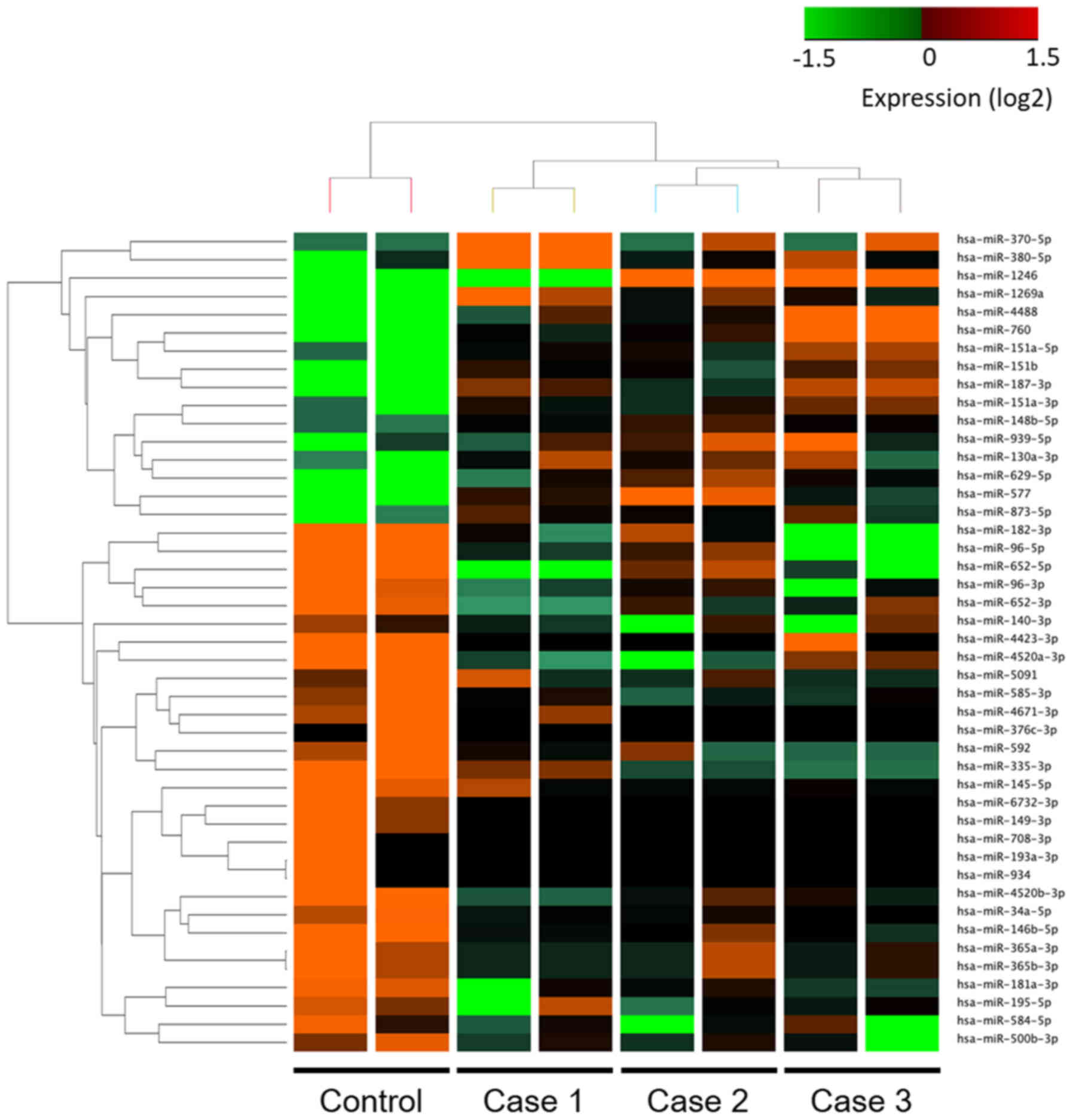|
1
|
Shields JA, Demirci H, Marr BP, Eagle RC
Jr and Shields CL: Sebaceous carcinoma of the ocular region: A
review. Surv Ophthalmol. 50:103–122. 2005. View Article : Google Scholar : PubMed/NCBI
|
|
2
|
Cook BE Jr and Bartley GB: Epidemiologic
characteristics and clinical course of patients with malignant
eyelid tumors in an incidence cohort in Olmsted County, Minnesota.
Ophthalmology. 106:746–750. 1999. View Article : Google Scholar : PubMed/NCBI
|
|
3
|
Takamura H and Yamashita H:
Clinicopathological analysis of malignant eyelid tumor cases at
Yamagata university hospital: Statistical comparison of tumor
incidence in Japan and in other countries. Jpn J Ophthalmol.
49:349–354. 2005. View Article : Google Scholar : PubMed/NCBI
|
|
4
|
Buitrago W and Joseph AK: Sebaceous
carcinoma: the great masquerader: emgerging concepts in diagnosis
and treatment. Dermatol Ther. 21:459–466. 2008. View Article : Google Scholar : PubMed/NCBI
|
|
5
|
Lai TF, Huilgol SC, Selva D and James CL:
Eyelid sebaceous carcinoma masquerading as in situ squamous cell
carcinoma. Dermatol Surg. 30:222–225. 2004. View Article : Google Scholar : PubMed/NCBI
|
|
6
|
Kan LW, Leu YS, Tzen CY and Wu CH:
Recurrent sebaceous gland carcinoma of eyelid previously diagnosed
as basal cell carcinoma: Case report. Am J Otolaryngol. 32:620–623.
2011. View Article : Google Scholar : PubMed/NCBI
|
|
7
|
Jakobiec FA and Mendoza PR: Eyelid
sebaceous carcinoma: Clinicopathologic and multiparametric
immunohistochemical analysis that includes adipophilin. Am J
Ophthalmol. 157:186–208.e2. 2014. View Article : Google Scholar : PubMed/NCBI
|
|
8
|
Milman T, Schear MJ and Eagle RC Jr:
Diagnostic utility of adipophilin immunostain in periocular
carcinomas. Ophthalmology. 121:964–971. 2014. View Article : Google Scholar : PubMed/NCBI
|
|
9
|
Mulay K, White VA, Shah SJ and Honavar SG:
Sebaceous carcinoma: Clinicopathologic features and diagnostic role
of immunohistochemistry (including androgen receptor). Can J
Ophthalmol. 49:326–332. 2014. View Article : Google Scholar : PubMed/NCBI
|
|
10
|
Yunoki T, Miyakoshi A, Otsuka M and
Hayashi A: Clinicopathological features of considerable reduction
in androgen receptor expression in sebaceous gland carcinoma of the
eyelid. Int Ophthalmol. 39:1703–1708. 2019. View Article : Google Scholar : PubMed/NCBI
|
|
11
|
Shields JA, Demirci H, Marr BP, Eagle RC
Jr and Shields CL: Sebaceous carcinoma of the eyelids: Personal
experience with 60 cases. Ophthalmology. 111:2151–2157. 2004.
View Article : Google Scholar : PubMed/NCBI
|
|
12
|
Zürcher M, Hintschich CR, Garner A, Bunce
C and Collin JR: Sebaceous carcinoma of the eyelid: A
clinicopathological study. Br J Ophthalmol. 82:1049–1055. 1998.
View Article : Google Scholar : PubMed/NCBI
|
|
13
|
Muqit MM, Roberts F, Lee WR and Kemp E:
Improved survival rates in sebaceous carcinoma of the eyelid. Eye
(Lond). 18:49–53. 2004. View Article : Google Scholar : PubMed/NCBI
|
|
14
|
Song A, Carter KD, Syed NA, Song J and
Nerad JA: Sebaceous cell carcinoma of the ocular adnexa: Clinical
presentations, histopathology, and outcomes. Ophthal Plast Reconstr
Surg. 24:194–200. 2008. View Article : Google Scholar : PubMed/NCBI
|
|
15
|
Kiyosaki K, Nakada C, Hijiya N, Tsukamoto
Y, Matsuura K, Nakatsuka K, Daa T, Yokoyama S, Imaizumi M and
Moriyama M: Analysis of p53 mutations and the expression of p53 and
p21WAF1/CIP1 protein in 15 cases of sebaceous carcinoma of the
eyelid. Invest Ophthalmol Vis Sci. 51:7–11. 2010. View Article : Google Scholar : PubMed/NCBI
|
|
16
|
Jayaraj P, Sen S, Dhanaraj PS, Jhajhria R,
Singh S and Singh VK: Immunohistochemical expression of X-linked
inhibitor of apoptosis in eyelid sebaceous gland carcinoma predicts
a worse prognosis. Indian J Ophthalmol. 65:1109–1113. 2017.
View Article : Google Scholar : PubMed/NCBI
|
|
17
|
Yunoki T, Tabuchi Y and Hayashi A:
Expression of anti-apoptotic protein BAG3 in human sebaceous gland
carcinoma of the eyelid. Anticancer Res. 37:1931–1934. 2017.
View Article : Google Scholar : PubMed/NCBI
|
|
18
|
Erovic BM, Al Habeeb A, Harris L,
Goldstein DP, Kim D, Ghazarian D and Irish JC: Identification of
novel target proteins in sebaceous gland carcinoma. Head Neck.
35:642–648. 2013. View Article : Google Scholar : PubMed/NCBI
|
|
19
|
Bhardwaj M, Sen S, Sharma A, Kashyap S,
Chosdol K, Pushker N, Bajaj MS and Bakhshi S: ZEB2/SIP1 as novel
prognostic indicator in eyelid sebaceous gland carcinoma. Hum
Pathol. 46:1437–1442. 2015. View Article : Google Scholar : PubMed/NCBI
|
|
20
|
Lee MJ, Kim N, Choung HK, Choe JY, Khwarg
SI and Kim JE: Increased gene copy number of HER2 and concordant
protein overexpression found in a subset of eyelid sebaceous gland
carcinoma indicate HER2 as a potential therapeutic target. J Cancer
Res Clin Oncol. 142:125–133. 2016. View Article : Google Scholar : PubMed/NCBI
|
|
21
|
Kim N, Choung HK, Lee MJ, Khwarg SI and
Kim JE: Cancer stem cell markers in eyelid sebaceous gland
carcinoma: High expression of ALDH1, CD133, and ABCG2 correlates
with poor prognosis. Invest Ophthalmol Vis Sci. 56:1813–1819. 2015.
View Article : Google Scholar : PubMed/NCBI
|
|
22
|
Yunoki T, Hirano T, Tabuchi Y, Furusawa Y,
Torigoe M, Nakajima T, Imura J and Hayashi A: CDKN2A, CDK1, and
CCNE1 overexpression in sebaceous gland carcinoma of eyelid. Int
Ophthalmol. 40:343–350. 2020. View Article : Google Scholar : PubMed/NCBI
|
|
23
|
Olive V, Minella AC and He L: Outside the
coding genome, mammalian microRNAs confer structural and functional
complexity. Sci Signal. 8:re22015. View Article : Google Scholar : PubMed/NCBI
|
|
24
|
Kent OA and Mendell JT: A small piece in
the cancer puzzle: microRNAs as tumor suppressors and oncogenes.
Oncogene. 25:6188–6196. 2006. View Article : Google Scholar : PubMed/NCBI
|
|
25
|
Zhang B, Pan X, Cobb GP and Anderson TA:
microRNAs as oncogenes and tumor suppressors. Dev Biol. 302:1–12.
2007. View Article : Google Scholar : PubMed/NCBI
|
|
26
|
Lu J, Getz G, Miska EA, Alvarez-Saavedra
E, Lamb J, Peck D, Sweet-Cordero A, Ebert BL, Mak RH, Ferrando AA,
et al: MicroRNA expression profiles classify human cancers. Nature.
435:834–838. 2005. View Article : Google Scholar : PubMed/NCBI
|
|
27
|
Hayes J, Peruzzi PP and Lawler S:
MicroRNAs in cancer: Biomarkers, functions and therapy. Trends Mol
Med. 20:460–469. 2014. View Article : Google Scholar : PubMed/NCBI
|
|
28
|
Bhardwaj M, Sen S, Chosdol K, Sharma A,
Pushker N, Kashyap S, Bakhshi S and Bajaj MS: miRNA-200c and
miRNA-141 as potential prognostic biomarkers and regulators of
epithelial-mesenchymal transition in eyelid sebaceous gland
carcinoma. Br J Ophthalmol. 101:536–542. 2017. View Article : Google Scholar : PubMed/NCBI
|
|
29
|
Bladen JC, Wang J, Sangaralingam A,
Moosajee M, Fitchett C, Chelala C, Beaconsfield M, O'Toole EA,
Philpott MP and Ezra DG: MicroRNA and transcriptome analysis in
periocular Sebaceous Gland Carcinoma. Sci Rep. 8:75312018.
View Article : Google Scholar : PubMed/NCBI
|
|
30
|
Tetzlaff MT, Curry JL, Yin V,
Pattanaprichakul P, Manonukul J, Uiprasertkul M, Manyam GC, Wani
KM, Aldape K, Zhang L, et al: Distinct pathways in the pathogenesis
of sebaceous carcinomas implicated by differentially expressed
microRNAs. JAMA Ophthalmol. 133:1109–1116. 2015. View Article : Google Scholar : PubMed/NCBI
|
|
31
|
Furusawa Y, Yunoki T, Hirano T, Minagawa
S, Izumi H, Mori H, Hayashi A and Tabuchi Y: Identification of
genes and genetic networks associated with BAG3 dependent cell
proliferation and cell survival in human cervical cancer HeLa
cells. Mol Med Rep. 18:4138–4146. 2018.PubMed/NCBI
|
|
32
|
Kaliki S, Ayyar A, Dave TV, Ali MJ, Mishra
DK and Naik MN: Sebaceous gland carcinoma of the eyelid:
Clinicopathological features and outcome in Asian Indians. Eye
(Lond). 29:958–963. 2015. View Article : Google Scholar : PubMed/NCBI
|
|
33
|
Wang Q, Yang J, Lin X, Huang Z, Xie C and
Fan H: Spot14/Spot14R expression may be involved in MSC adipogenic
differentiation in patients with adolescent idiopathic scoliosis.
Mol Med Rep. 13:4636–4642. 2016. View Article : Google Scholar : PubMed/NCBI
|
|
34
|
Wells WA, Schwartz GN, Morganelli PM, Cole
BF, Gibson JJ and Kinlaw WB: Expression of ‘Spot 14’ (THRSP)
predicts disease free survival in invasive breast cancer:
Immunohistochemical analysis of a new molecular marker. Breast
Cancer Res Treat. 98:231–240. 2006. View Article : Google Scholar : PubMed/NCBI
|
|
35
|
Donnelly C, Olsen AM, Lewis LD, Eisenberg
BL, Eastman A and Kinlaw WB: Conjugated linoleic acid (CLA)
inhibits expression of the Spot 14 (THRSP) and fatty acid synthase
genes and impairs the growth of human breast cancer and liposarcoma
cells. Nutr Cancer. 61:114–122. 2009. View Article : Google Scholar : PubMed/NCBI
|
|
36
|
Goldstein JL and Brown MS: The LDL
receptor. Arterioscler Thromb Vasc Biol. 29:431–438. 2009.
View Article : Google Scholar : PubMed/NCBI
|
|
37
|
Basel-Vanagaite L, Zevit N, Har Zahav A,
Guo L, Parathath S, Pasmanik-Chor M, McIntyre AD, Wang J,
Albin-Kaplanski A, Hartman C, et al: Transient infantile
hypertriglyceridemia, fatty liver, and hepatic fibrosis caused by
mutated GPD1, encoding glycerol-3-phosphate dehydrogenase 1. Am J
Hum Genet. 90:49–60. 2012. View Article : Google Scholar : PubMed/NCBI
|
|
38
|
Lee EK, Lee MJ, Abdelmohsen K, Kim W, Kim
MM, Srikantan S, Martindale JL, Hutchison ER, Kim HH, Marasa BS, et
al: miR-130 suppresses adipogenesis by inhibiting peroxisome
proliferator-activated receptor gamma expression. Mol Cell Biol.
31:626–638. 2011. View Article : Google Scholar : PubMed/NCBI
|
|
39
|
Kim N, Kim JE, Choung HK, Lee MJ and
Khwarg SI: Expression of cell cycle regulatory proteins in eyelid
sebaceous gland carcinoma: Low p27 expression predicts poor
prognosis. Exp Eye Res. 118:46–52. 2014. View Article : Google Scholar : PubMed/NCBI
|
|
40
|
Bell WR, Singh K, Rajan Kd A and Eberhart
CG: Expression of p16 and p53 in intraepithelial periocular
sebaceous carcinoma. Ocul Oncol Pathol. 2:71–75. 2015. View Article : Google Scholar : PubMed/NCBI
|
|
41
|
Liau JY, Liao SL, Hsiao CH, Lin MC, Chang
HC and Kuo KT: Hypermethylation of the CDKN2A gene promoter is a
frequent epigenetic change in periocular sebaceous carcinoma and is
associated with younger patient age. Hum Pathol. 45:533–539. 2014.
View Article : Google Scholar : PubMed/NCBI
|
|
42
|
Li Z, Wang H, Wang Z and Cai H: MiR-195
inhibits the proliferation of human cervical cancer cells by
directly targeting cyclin D1. Tumour Biol. 37:6457–6463. 2016.
View Article : Google Scholar : PubMed/NCBI
|
|
43
|
Zhong J, Yuan H, Xu X and Kong S: MicroRNA
195 inhibits cell proliferation, migration and invasion by
targeting defective in cullin neddylation 1 domain containing 1 in
cervical cancer. Int J Mol Med. 42:779–788. 2018.PubMed/NCBI
|
|
44
|
Hui W, Yuntao L, Lun L, WenSheng L,
ChaoFeng L, HaiYong H and Yueyang B: MicroRNA-195 inhibits the
proliferation of human glioma cells by directly targeting cyclin D1
and cyclin E1. PLoS One. 8:e549322013. View Article : Google Scholar : PubMed/NCBI
|
|
45
|
Liu H, Chen Y, Li Y, Li C, Qin T, Bai M,
Zhang Z, Jia R, Su Y and Wang C: miR-195 suppresses metastasis and
angiogenesis of squamous cell lung cancer by inhibiting the
expression of VEGF. Mol Med Rep. 20:2625–2632. 2019.PubMed/NCBI
|
|
46
|
Ye X and Chen X: miR-149-5p inhibits cell
proliferation and invasion through targeting GIT1 in medullary
thyroid carcinoma. Oncol Lett. 17:372–378. 2019.PubMed/NCBI
|
|
47
|
Jin L, Li Y, Liu J, Yang S, Gui Y, Mao X,
Nie G and Lai Y: Tumor suppressor miR-149-5p is associated with
cellular migration, proliferation and apoptosis in renal cell
carcinoma. Mol Med Rep. 13:5386–5392. 2016. View Article : Google Scholar : PubMed/NCBI
|













